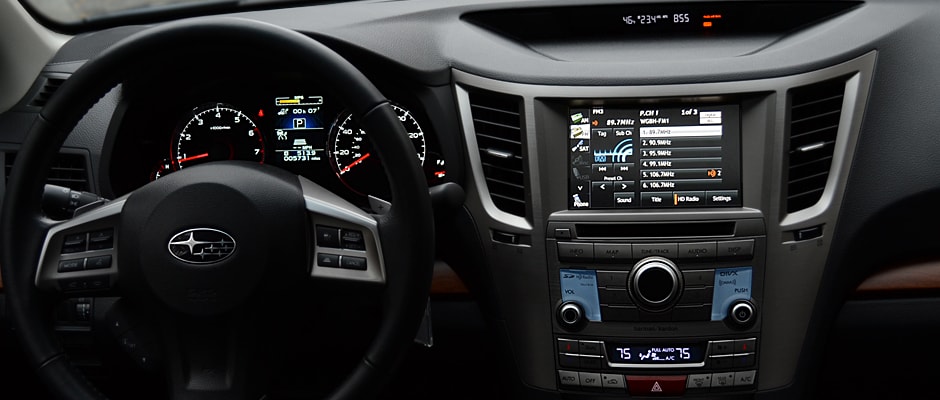Introduction
A car that nearly drives itself? Surprise! It's a Subaru.
Wait — a high-tech Subaru? While it's true the company has traded on a no-nonsense image, from its spacious wagons and bare-bones rally cars right down to its promotional tie-ins with L.L. Bean, there's still some room for technology on board. Even so, the new Outback is still a Subaru through-and-through.
Tech & Entertainment
EyeSight dynamic cruise control is a standout
We first learned about EyeSight when it debuted at last year's New York Auto Show, and were excited to test it in real-world conditions. Here's how it works: When you're driving on the highway, turn on the EyeSight adaptive cruise control and set the distance you want between your bumper and the car in front of you. The cameras will speed up and slow down the car as needed, even down to a stop. If traffic comes to a complete halt, you'll have to re-engage the system, since it won't speed away from still in case you've stopped for a light or an emergency. Otherwise, driving is just steering.
I tried out EyeSight in Boston-area rush-hour traffic on a new Outback, and came away totally impressed. I've used dozens of other adaptive cruise control systems, mostly in luxury cars, and Subaru's system feels the most natural. It only pays attention to the car immediately in front, so it can be a bit unnerving to notice brake lights up ahead before your car starts to slow, but in our tests the car always stopped in time. It even recognized cross-traffic, such as a merging truck or a guy cutting you off. And you'll get cut off often, since the Subie leaves plenty of room for the Holy Ghost between you and the next car.
Even without the cruise control on, EyeSight will slam on the brakes for you in the event of an imminent collision, a task we thankfully didn't have the chance to test. Lane departure warning can also be turned on, but there's no way to monitor blind spots. Thankfully, this wagon has excellent visibility.
Among the other upgrades for 2013, Subaru finally replaced their miserably outdated, tiny TomTom removable nav unit to a much larger, more elegant interface from Fujitsu. We had no problems using it, and it's simple enough for even the crustiest Yankee, even one who swears you can't get theah from heah. Connecting a smartphone as a music player was similarly painless.
In addition, Subaru is planning to add Harman's Aha smartphone link to later versions of the 2013 Outback. Our early-build tester, sadly, was not equipped with the connectivity suite, but we did get the chance to try it out on a Honda Accord. It showed promise, but didn't quite feel ready for prime time.
{{photo_gallery "Tech Pics"}}
Design
You won't mistake the Outback for anything but a Subaru
Inoffensive and anodyne, Subaru's interiors are slightly classier than those from Mazda or Mitsubishi, but not quite as design-forward as what larger manufacturers offer. If you like fads such as fake carbon fiber or oddly-shaped buttons, look elsewhere. Though it's far from innovative, the Subaru's dash is a classic, with large buttons big enough for glove-wearing New Englanders to press in the dead of winter. If you have trouble figuring out the controls on a Outback, you shouldn't be driving.
Seats are comfortable, and there's great legroom in the back, and overall interior space is similar to crossovers with higher centers of gravity. Compared to other Subarus, the Forester is a bit taller but not as long. Outside, minor cosmetic updates distinguish the new Outback from prior models, and all that tough-looking body cladding might as well be replaced with a sign that says, "I am not a station wagon."
{{photo_gallery "Design Pics"}}
Driving Experience
The tester we drove featured the famed Subaru "boxer" four-cylinder engine, so named because the pistons move together horizontally, like boxers' gloves. Boxer engines tend to be smaller and able to sit low in the engine bay, which gives makes boxer engine-equipped cars a low center of gravity (good for driving dynamics) and lighter weight (good for fuel economy and performance).
Even though it only has a four-cylinder engine, the Outback doesn't feel underpowered. It's not a drag racer by any means, but it has no problem climbing hills and keeping up with traffic. Laden with cargo and passengers, the wagon was a bit harsher than other cars we've driven, but most Subarus tend to be a bit unrefined when it comes to noise reduction and engine vibration.
Conclusion
The traditionalists might balk, but EyeSight is impressive
Just because Subaru built their reputation on no-nonsense cars doesn't mean they can't add technological advancements. We're sure that many traditional Subaru buyers will opt out of EyeSight for now, but it's heartening to see the oh-so-traditional company join the active safety revolution.
Trim Levels
Subaru offers five trim levels on the Outback, all of which feature all-wheel drive, but with varying degrees of luxury. Options are parceled out depending on the engine and transmission choices. Among cars with the 2.5 liter four-cylinder engine are the base model — a bare-bones car with basically no options which starts at $23,495 with a manual transmission — and the Premium trim level, which adds a power driver's seat. On 2.5i Premium with a manual transmission, you can only get an optional "winter package" which includes heated seats, heated side mirrors and windshield wiper de-icers. Adding the CVT gives the option of a moonroof and an upgraded Harman/Kardon audio system.
The 2.5i Limited trim adds leather and comes standard with the Harmon/Kardon sound system and the CVT. EyeSight is only available in the Moonroof + Navigation + EyeSight package, which will add another $3940. So equipped, the Outback runs about $33,335.
If you choose the 3.6 liter six-cylinder engine, you're limited to a five-speed automatic transmission. The base model lacks any option packages, but the Limited trim opens up a moonroof, navigation and EyeSight. So equipped, it's $36,035.
Powertrain
Subaru offers a 2.5 liter, 173 hp "boxer" four-cylinder engine with the choice of a manual transmission or CVT. To get EyeSight or navigation, you have to step up to the Limited trim, which eliminates the choice of a manual transmission.
You can also get a 3.6 liter, 256 hp six-cylinder engine on the 3.6R trim-level cars. A five-speed automatic is the only transmission choice.
Safety
The National Highway Traffic Safety Administration (NHTSA) has yet to review the new 2013 Outback for crashworthiness, but they have given it four stars for rollover avoidance, since the car had a low risk of rolling over.
The Insurance Institute for Highway Safety (IIHS) gave the 2013 Outback a Top Safety Pick Plus, with top "Good" ratings for side impact, moderate overlap frontal impact, and roof strength tests. It got an "Adequate" in the small overlap test, which simulates hitting a pole or a narrow barrier with a quarter of the car's frontal area at a speed of 40 mph. While passenger injury measures were still rated "Good" indicating a low risk of injury, the car's overall structure was compromised and therefore rated "Marginal."
Fuel Economy
Fuel economy depends on the engine and transmission choice.
The version we tested, a four-cylinder model with a CVT, is EPA rated at 24 city, 30 highway. We saw numbers at the low end of that range in real-world testing. The six-cylinder version is rated at 18 city, 25 highway, while a four-cylinder with a manual transmission is rated 21 city, 28 highway.
Meet the tester
Keith was the Editor in Chief of Reviewed's appliance and automotive sites. His work has appeared in publications such as Wired, Car & Driver, and CityLab.
Checking our work.
Our team is here to help you buy the best stuff and love what you own. Our writers, editors, and experts obsess over the products we cover to make sure you're confident and satisfied. Have a different opinion about something we recommend? Email us and we'll compare notes.
Shoot us an email

